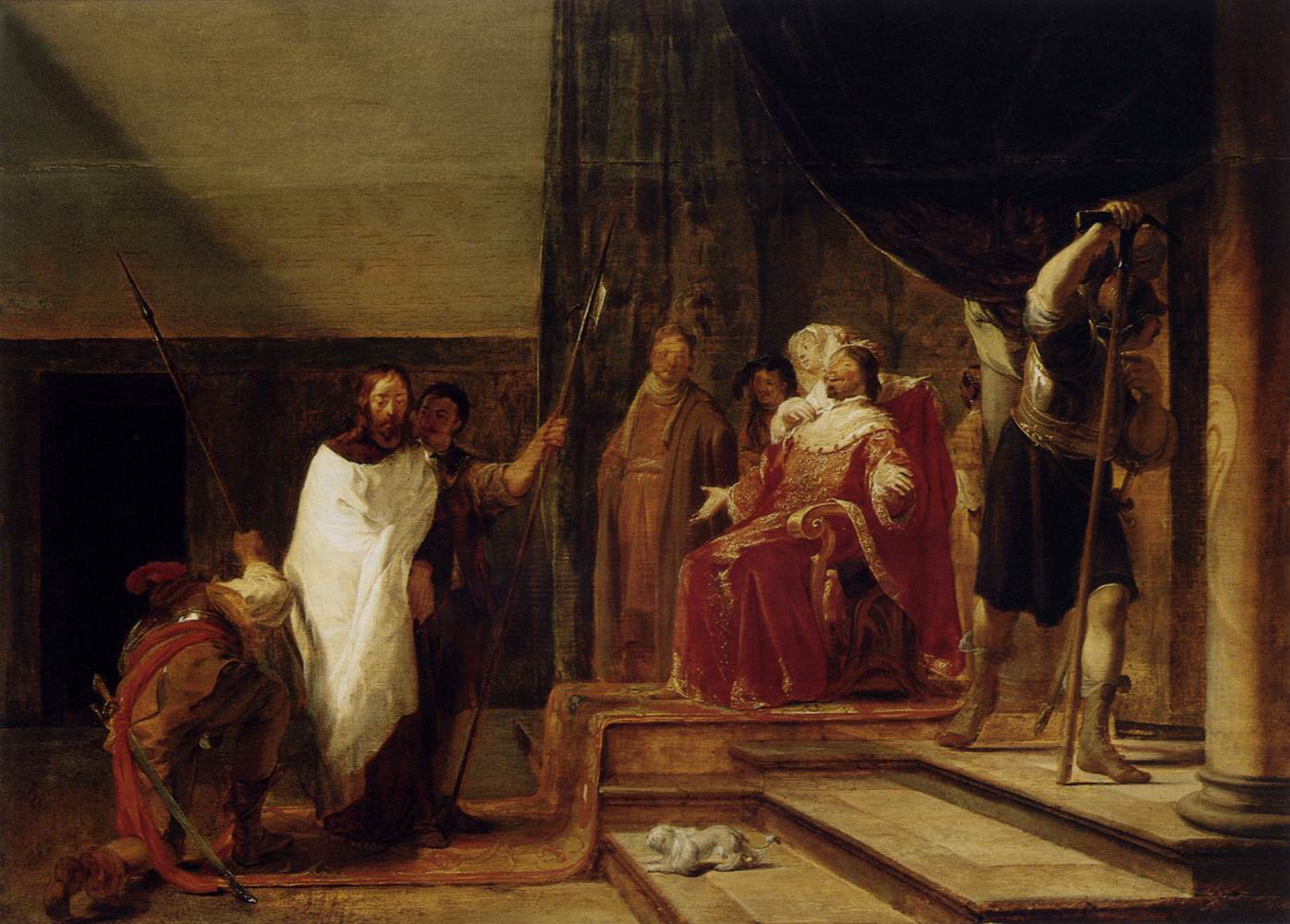In the Gospel according to Luke, the centurion overseeing Jesus’ death comes out and says what we all think: “This man really was innocent” (23:47). The reader no longer must puzzle out Jesus’ last despairing cry, “My God, My God, why have you abandoned me?” (Mark 15:34).
The author heavily edits the Marcan narrative, rewriting the Jewish martyr motif of Mark’s gospel into the Hellenistic noble death model, as exemplified in Plato’s account of Socrates’ death. Jesus dies nobly, like Socrates.
The noble death has two major aspects: demonstrate the accused’s innocence and show the accused in control. To accomplish this requires a radical editing of the Marcan narrative. The author follows the Marcan narrative frame—time and place makers—but invents new dialogue.
Since Jesus no longer cries out “Eloi, Eloi, lema sabachtani,” there is no need for the bystanders to suppose he’s calling for Elijah. With the bystanders’ mistake eliminated, the editor creates a much tighter presentation of Jesus’ death. The editor keeps the Marcan time marker, “about noon,” as well as “darkness blanketed the whole land,” but adds “an eclipse of the sun” (23:44–45). Then the narrator notes, “The curtain of the temple was torn down the middle.” In Mark the dramatic rending of the temple’s veil occurs at Jesus’ death as an allegorical foretelling of the temple’s destruction in 70 CE by Titus. In Luke it occurs before Jesus dies as the conclusion to the introduction setting the scene for his death. (Aside: all this is easier to see in a gospel parallels, like Dewey & Miller, The Complete Gospel Parallels.) The editor’s strategy downplays apocalyptic signs at Jesus’ death and focuses on his noble death.
The author does not completely disassociate Jesus’ death from the destruction of the temple. As Jesus is led from his trial before Pilate to the place of crucifixion, he meets a group of “women who mourned and lamented him” (23:27). Jesus warns them, “Daughters of Jerusalem, do not weep for me. Weep instead for yourselves and for your children” (23:28). This episode fits with the noble death motif. Jesus on his way to his own execution shows empathy for the suffering of the women and by extension all the people of Jerusalem who suffered terribly in the city’s siege.

In the Greco-Roman model, men must show control, while women lack control. That is clearly present in this episode. In Plato’s Phaedo, Socrates sends the women away to avoid such a scene of wailing women. But one of his friends could not hold back the tears, and all Socrates’ friends “burst into tears except Socrates himself” (117d). Socrates lectures his followers: “What are you doing, you strange people? This was the main reason I sent the women away so they wouldn’t disrupt things in such a way. For I’ve heard it said one should die in silence. Do calm down and pull yourselves together” (117c–d). The contrast with the Jerusalem women is telling. Jesus and the women conform to the Hellenistic models for male and female behavior. But none of Jesus’ male followers are in the scene. And Jesus shows compassion for the women. Furthermore, Jesus’ silence throughout his passion, as recommended by Socrates, is often noted.
This episode’s construction comes straight from the schoolbook. An apothegm, in this case a beatitude, forms the nucleus around which the author created a scene with dialog. The beatitude is traditional as evidenced by its appearance in both Luke and Thomas.
“Congratulations to those who are infertile, to the wombs that never gave birth, and to the breasts that never nursed!” (Luke 23:29)
“Congratulations to the womb that has not conceived and the breasts that have not given milk.” (GThm 79)
The motif of a noble death dominates Jesus' dying words in Luke.
Mark 15:34
And at three o’clock in the afternoon Jesus shouted at the top of his voice, “Eloi, Eloi, lema sabachtani” (which means, “My God, my God, why have you abandoned me?”
Luke 23:46
Then Jesus shouted at the top of his voice, “Father, into your hands I entrust my spirit.” Having said this, he breathed his last (from Mark 15:37).
The author of Luke’s Gospel adopts the Marcan narrator’s comments (underlined) but creates a completely new exclamation for Jesus as part of his program of Jesus’ noble death. Jesus has been the active agent in his own execution since his arrest in the garden. When one of his followers cut off the ear of the chief priest’s slave, “Jesus responded, ‘Stop! That’s enough!’ And he touched his ear and healed him” (22:51).
In his dying words he still remains in control. He places before (paratithēmi), entrusts, offers, or presents his “spirit“ (pneuma) into God’s hands. The primary meaning of pneuma is breath and that is its sense here. The Greek composition makes a wordplay on breath/breathe. “’Into your hands I entrust my last breath (pneuma).’ Having said this, he breathed (exepneusen) his last.”
He addresses God as his Father, a much more common address in Luke than Mark. In Mark, Jesus only addresses God as Father once (14:36//Luke 22:42), while in Luke he addresses God as Father eleven times.
The first time Jesus speaks in this narrative, while with his parents on a trip to Jerusalem, the author makes a wordplay on “father.” Finding the twelve-year-old teaching in the temple, his mother reproaches him, like a good mother, “why have you done this to us? Behold, your father and I have been worried sick looking for you” (2:48). He responds, “Don’t you know that I’m destined to do my Father’s business?” (2:49). Clearly in this story neither Joseph nor Mary knows who Jesus’ true father is. When teaching his students to pray, he instructs them to say, “Father, your name be revered” (11:2). In Gethsemane he prays, “Father, if you so choose, take this cup away from me!” (22:42). And in his final words to the Eleven, he promises, “I’m sending down on you what my Father promised. Stay here in the city until you are invested with power from on high” (24:49).
In Mark, Jesus addresses an apparently uncaring, silent, and impersonal God. Father, on the other hand, denotes a personal, familial relationship. Jesus’ first words in this gospel refer to “my father’s business,” while his last words refer to "what my Father promised.” This inclusio makes the address on the cross even more significant.
Socrates’ last words also show him in control and taking care of religious obligations. “These were the last words he uttered—'Crito,’ he said, ‘we owe Asclepius a cock. See that you all buy one, and don’t forget’” (Phaedo 118). Asclepius is the god of healing and Socrates is making a witty remark that death is a cure for life, a major theme of Phaedo.
As we have seen, compared to Mark, Luke’s editing and rewriting of Jesus’ death scene is not only considerably shorter but heavily rewritten. This pattern continues with the centurion’s response. Luke removes all ambivalence. The narrator notes: “Now when the Roman officer saw what happened, he praised God” (23:47). What he had seen was Jesus dying a noble death. Then the centurion exclaims: “This man really was innocent!”
The innocence of the condemned is a major theme in the noble death model. The executioner in Plato’s Phaedo addresses Socrates before administering the poison.
“I have come to know that you particularly are the most noble, the most gentle and finest man who has ever come here. . . . I have come to tell you, farewell and try to bear what you have to as easily as you can.” And with that he burst into tears, turned round and began to leave. (116c–d)
The executioner acknowledges both Socrates’ nobility and innocence.
The author of Luke’s Gospel has taken special care to stress this theme during Jesus’ various interrogations and trials. The preliminary trial before the Sanhedrin turns into a mob action. “The elders of the people convened, along with the chief priests and scholars. They had him brought before their Council, where they interrogated him” (22:66). He is interrogated by a group, not an individual. And they all pronounce judgment. “Why do we still need witnesses? We have heard it ourselves from his own mouth” (22:71).

Beginning in the first session, Pilate pronounces: “In my judgment there is no case against this man” (23:4). When the chief priests (sic) and crowds persist, Pilate figures out that Jesus comes under Herod’s jurisdiction and sends him to Herod, who was in Jerusalem for the feast. Herod is intrigued and hopes to see Jesus perform some sign, the spirit of which Jesus Christ Superstar perfectly captures. “All this time the chief priests and the scholars were standing around, hurling accusation after accusation against him” (23:10). Herod sends him back to Pilate. “That very day Herod and Pilate became friends; prior to this they had been constantly at odds” (23:12). Herod got his sign, a healing, but not in the way he had expected. The Herod episode, a clear Lucan creation, advances the innocence of Jesus and his complete control of the situation.
Pilate opens the second session with a statement to the Jewish authorities.
“You brought this man to me because you claim he’s been corrupting the people. Now look, after interrogating him in your presence, I have found in this man no grounds at all for your charges against him. Nor has Herod, since he sent him back to us. In fact, he has done nothing to deserve death. So I will teach him a lesson and set him free.” (23:13–16)
After three pronouncements of Jesus’ innocence, Pilate gave in and “ruled that their demand should be carried out . . . . but Jesus he handed over to their will” (23:24–25). Four times Pilate pronounces Jesus innocent. In Luke’s telling, the blame now falls on the Jewish leadership and people. The narrator returns to this theme at the conclusion of the death scene. After the centurion pronounces Jesus innocent, the narrator notes: “And when the throng of people that had gathered for this spectacle observed what had transpired, they all returned home beating their chests” (23:48). Jesus’ noble death is preserved but at what price?
Even one of the criminals who were crucified with him proclaims his innocence. “We are getting justice, since we are getting what we deserve. But this man has done nothing wrong” (23:41). Jesus remains firmly in control when he grants the criminal’s wish: “today you’ll be with me in Paradise” (23:43).
The author of Luke builds on a framework inherited from Mark but elaborates and creates a very different image. Gone is Mark’s challenge to the reader to figure out who Jesus is. In its place, new dialog depicts Jesus’ death in the Hellenistic model of a noble death. Jesus remains in charge and in control. He heals the ear of the high priest’s slave, comforts the weeping women, dies with a noble entrusting of his last breath to his Father. Everyone finds him innocent but the Jewish leadership and people.
Subscribe to our email list and receive updates, news, and more.
Join the Conversation in the Westar Public Square
We’re updating how we engage with your thoughtful feedback! Blog post comments will no longer be hosted on our website. Instead, members can join the conversation in the Westar Public Square, where blog post links will be shared for deeper discussions.
Not a member yet? Join us to connect with a vibrant community exploring progressive religious scholarship! Become a Member Today